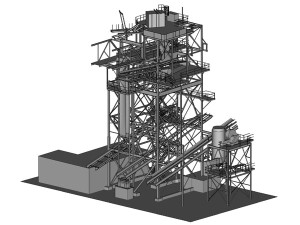 Building Information Modeling (BIM) has transformed the Architecture, Engineering, & Construction (AEC) industry by improving conventional design processes’ efficiency. Many studies have found collaborative solutions on BIM to improve client/team design relationships, accelerate the decision-making process, and significantly improve the ROI. But this is only the beginning.
Building Information Modeling (BIM) has transformed the Architecture, Engineering, & Construction (AEC) industry by improving conventional design processes’ efficiency. Many studies have found collaborative solutions on BIM to improve client/team design relationships, accelerate the decision-making process, and significantly improve the ROI. But this is only the beginning.
New trends, rising daily, promise to push BIM applications to unprecedented levels. In this post, we explore the top 5 innovative trends shaping the future of BIM:
- 3D Printing
While 3D printing is now considered a consolidated technology (at least, in its technical parts), its adoption to AEC is not yet widespread, although it is beginning to make waves. 3D printing has made it easier for professionals to create building elements quickly and efficiently. When incorporated with BIM processes, 3D printing can help accelerate prototypes’ development, thereby hastening the speed of a construction project.
Since BIM already serves as a rich source of geometric information for large-scale, commercially existing, and automated 3D machines, incorporating 3D printing and human workers on construction sites can be coordinated for improved safety and productivity.
3D printing allows the printing of digital files by layering down thin layers in successions. By creating physical forms quickly, teams can better collaborate on projects by equipping them to better understand and analyze the dynamics, functioning, and efficiency of structures. With the growing sophistication of 3D printing technology and its increasing adoption in the AEC industry, it can make a massive impact on BIM processes.
- Augmented Reality (AR) & Virtual Reality (VR)
BIM is the process of generating, storing, managing, exchanging, and sharing building information. A hot-spot in today’s technological space is the possible integration of BIM with virtual reality, where the user visualizes the virtual world and interacts with it.
By incorporating AR and VR, BIM can effectively address the problem of retrieving and presenting information concretely. Stakeholders will have a comprehensive and clear image of designs by immersing themselves in realistic 3D virtual environments. This makes it easy to follow every stage of the design process, identify errors, and engage in interactive and collaborative projects.
BIM and VR can be combined and proposed as a solution that allows the client’s inclusion into the design world. The possibilities are endless as a more sophisticated integration of BIM and VR comes into the picture.
- Cloud Software
Cloud-based collaboration continues to overtake functions that once consumed hard drive space on a designer or BIM manager’s computer. This boon has more data to be transferred to the cloud, making it easier for building team members to interact with centralized 3D models. With advanced data management tools like Assemble Systems, it is now easy to manage, store, and share project data over the cloud. Panzura Global Cloud Storage System is another software that includes a web-based OS, file-sharing system, and hardware controller.
Using a cloud framework makes BIM data accessible by anyone from anywhere, in real-time. This simplifies the BIM model sharing. Through this seamless connection, information can be quickly communicated to team members. And as you probably know, efficient communication saves time and money in the long run.
- Internet of Things (IoT)
BIM is typically used to model a building’s structure and systems during design and construction so that changes in one set of plans can be simultaneously updated in other affected plans. Incorporating IoT into BIM can be the catalyst we need for smart building projects.
If you’re wondering what IoT is, it refers to a system of interrelated, internet-connected objects that can collect and transfer data over a wireless network without human intervention.
IoT devices (sensors) can be used to capture real-time data into the BIM. This can then be used to model things like temperature trends, energy usage patterns, and even movements through the building. This information can be used to design more efficient future building projects.
- Drone Usage
AEC professionals and project managers are using drones for recording and reporting the progress of building projects. Being able to capture data of large areas in a short time accurately makes it feasible to easily refine BIM models to make them more reliable.
In the operation phase, the use of drones also protects human surveyors from risky situations. Easy monitoring with drones makes it possible to collect real-time pictures and videos uploaded to BIM collaboration platforms for involved professionals to access.
Drones are also applicable in the facility management phase. The long-life span of a building makes it difficult to ensure that maintenance will be consistently done responsibly. Drones allow for the easy updating of BIM models, which can be used for maintenance intervention plans.
Wrap Up
The possibilities of BIM are endless – thanks to the current innovative trends that are transforming the future of BIM. Some of the other game-changing trends worth mentioning include:
- Modular construction and prefabrication
- 3D laser scans
- Going green
- Direct product ordering
We’re here to help. Contact us today for more information.








